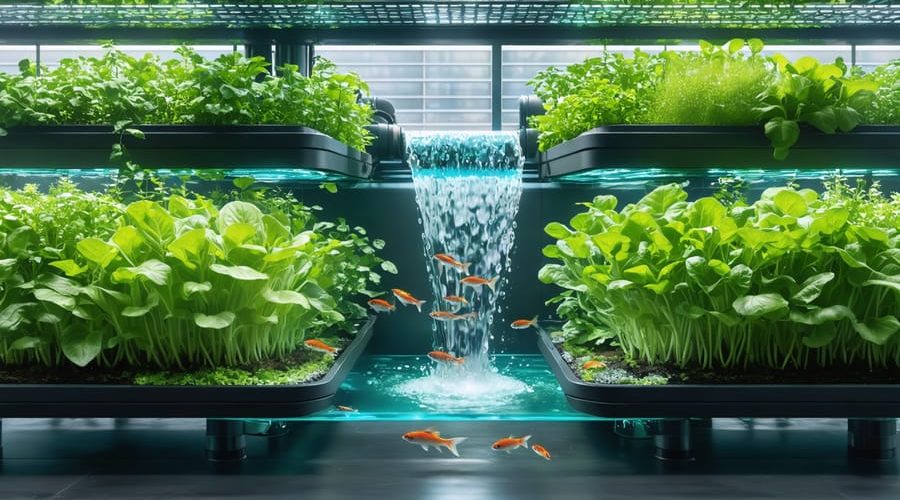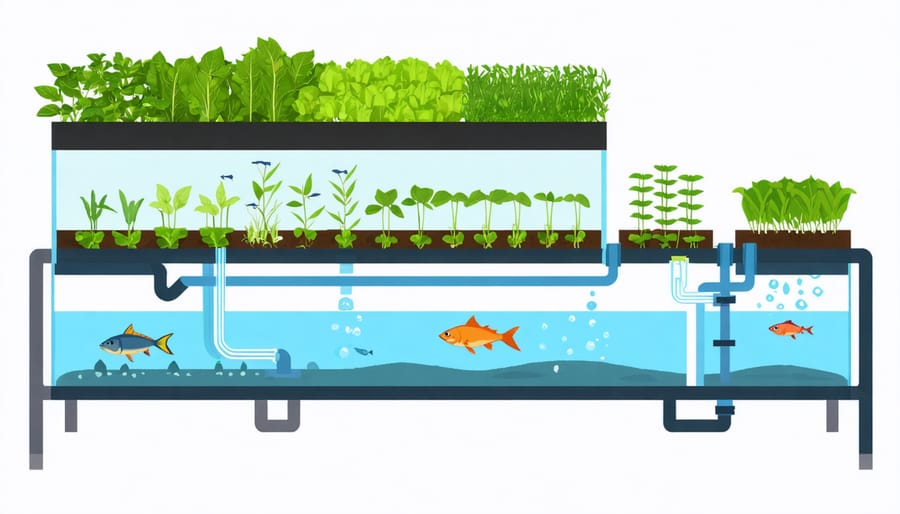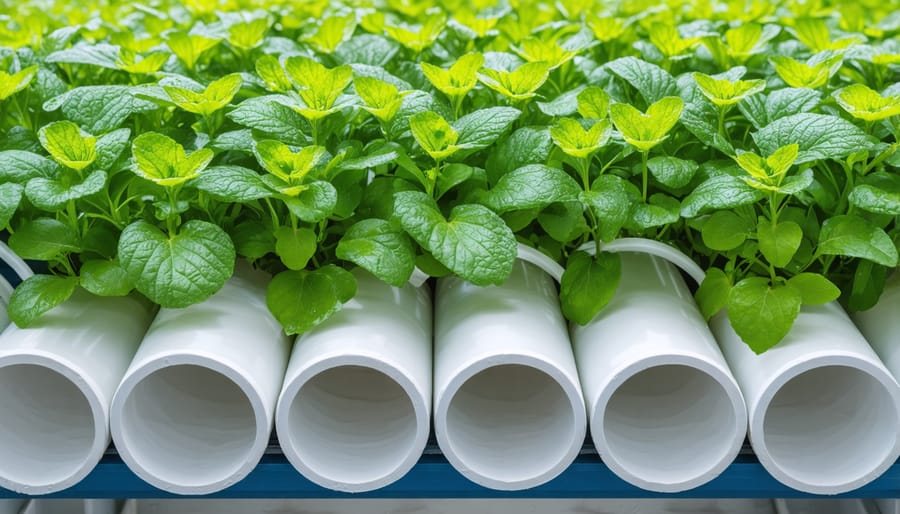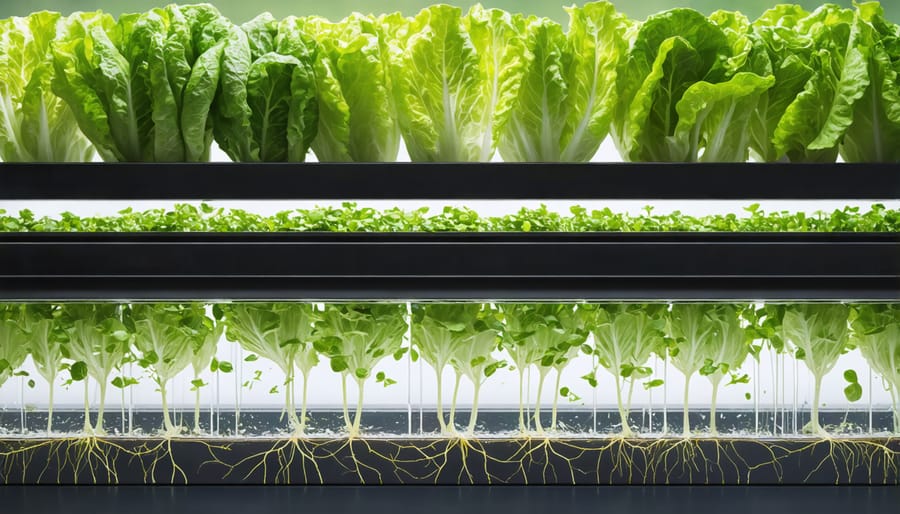
Boost Your Garden Yields with Aquaponics NFT: A Space-Saving Solution
Transform your traditional hydroponics setup into a thriving self-sustaining food system with Nutrient Film Technique (NFT) aquaponics. This innovative growing method combines fish cultivation with soilless plant production, creating a continuous flow of nutrient-rich water through shallow channels. Plants suspend their roots directly into this flowing stream, absorbing essential nutrients while naturally filtering the water for the fish below.
Unlike traditional hydroponic systems, NFT aquaponics eliminates the need for synthetic fertilizers, instead relying on fish waste to provide complete plant nutrition. This efficient, space-saving design typically produces faster growth rates than conventional gardening methods, while using up to 90% less water. Perfect for urban gardeners and sustainability enthusiasts, NFT aquaponics systems can be easily scaled from compact indoor setups to commercial operations.
Whether you’re growing leafy greens, herbs, or small fruiting plants, NFT aquaponics offers precise nutrient control and exceptional plant health monitoring capabilities. The shallow water flow ensures optimal oxygen levels for both root development and beneficial bacteria essential to the nitrogen cycle.
What Makes NFT Aquaponics Special
The Science Behind NFT
Nutrient Film Technique (NFT) in aquaponics is a clever way to grow plants using a thin stream of nutrient-rich water. Unlike traditional garden pond systems, NFT uses channels or pipes where plant roots hang directly into a shallow flowing water stream. Think of it as a tiny river delivering exactly what your plants need!
The ‘film’ part refers to the very shallow water flow – usually just 1/8 inch deep – that constantly moves past the plant roots. This thin film ensures roots get plenty of oxygen while accessing all the nutrients they need from the fish waste-enriched water. The beauty of NFT is that it’s super efficient with water usage since the same water keeps circulating through the system.
What makes NFT special is how the roots develop. The top portion stays dry and gets lots of air, while the bottom part stays in the nutrient film, creating the perfect balance for healthy growth. It’s like giving your plants the best of both worlds – air and water – in just the right proportions!

Benefits for Home Gardeners
NFT aquaponics offers several compelling advantages for home gardeners looking to maximize their growing space and efficiency. Unlike traditional media-based systems, NFT requires minimal growing media, making it significantly lighter and perfect for balconies, rooftops, or areas with weight restrictions. The system’s vertical design allows you to grow more plants in a smaller footprint – ideal for urban gardeners with limited space.
Maintenance becomes a breeze with NFT systems. The absence of growing media means less cleanup, no media replacement costs, and easier access to plant roots for monitoring health. Water consumption is notably lower compared to traditional methods, as the thin film of water recirculates efficiently through the system.
Plant growth tends to be faster in NFT systems because roots have direct access to nutrient-rich water and ample oxygen. You’ll also find it easier to harvest and replant, as plants simply lift out of their net pots without messy media. For year-round growing, NFT systems can be easily moved indoors during cold seasons, and their clean, modern appearance makes them an attractive addition to any home growing space.
Setting Up Your NFT Aquaponics System
Essential Components
Setting up a successful NFT aquaponics system requires several key components working together. The heart of the system is the grow channels – long, shallow tubes or gutters where plants grow. These channels, typically made from PVC pipes or food-grade guttering, need a slight slope (about 1:40) to ensure proper water flow.
You’ll need a reliable water pump to maintain constant circulation, and a fish tank or sump tank that serves as your water reservoir. When planning your hydroponics integration, choose a pump that can handle your system’s size – typically, a submersible pump rated at 250-400 gallons per hour works well for home setups.
Other essential items include:
– Net pots or growing cups to hold your plants
– Growing media (like expanded clay pellets) for plant support
– Air pump and air stones for oxygenating the fish tank
– Basic plumbing fittings (valves, connectors, and pipes)
– A timer to control pump cycles
– pH and water testing kits
– Solid support structure (often built from lumber or metal)
Don’t forget about biological components: hardy fish species like tilapia or goldfish, and beneficial bacteria colonies that will develop naturally in your system. Starting with quality components ensures your system runs smoothly and provides years of productive growing.

Assembly Steps
Let’s put your aquaponics NFT system together step by step! Start by gathering your materials: growing channels (food-grade PVC pipes work great), a fish tank, water pump, air pump, biofilter container, and necessary plumbing fittings.
Begin by setting up your fish tank in a level, stable location. Install the air pump and add appropriate aeration stones to ensure your fish have plenty of oxygen. Next, position your biofilter container slightly higher than the fish tank – this helps maintain proper water flow through gravity.
Mount your growing channels with a slight slope (about 1 inch drop per 8 feet) to ensure smooth water flow. Secure them firmly using sturdy brackets or supports. The channels should be positioned at a comfortable working height, typically around waist level.
Connect your plumbing system starting from the pump in the fish tank. Run tubing to the biofilter, then to the highest point of your growing channels. Install small holes or outlets in your channels where plants will sit – these should be spaced about 8 inches apart.
Create a return system by connecting the lower end of your growing channels back to the fish tank. This completes the water cycle. Test your system with plain water first to check for leaks and proper flow.
Finally, add your biofilter media and cycle your system for about two weeks before adding fish or plants. During this time, monitor water flow and make any necessary adjustments to ensure even distribution throughout the channels.
Remember to double-check all connections and support structures before adding water to prevent any unwanted surprises!
Water Flow Management
Proper water flow is crucial for success in NFT aquaponics systems. The nutrient-rich water should flow as a thin film (about 1/8 inch deep) through the growing channels, providing consistent nutrients to plant roots while maintaining adequate oxygenation. Aim for a flow rate of 1-2 liters per minute in each growing channel, which you can adjust using simple valve controls.
Regular monitoring and maintenance of your water management techniques are essential. Check your water flow daily to ensure there are no blockages or dry spots in the channels. A slight slope of 1-1.5% in your growing channels helps maintain proper flow while preventing water pooling.
Install a reliable water pump that can handle your system’s volume, and consider adding a backup pump for emergencies. Clean your filters weekly to prevent debris from clogging the channels. During hot weather, you might need to increase flow rates slightly to compensate for evaporation. Remember to maintain water temperature between 65-75°F (18-24°C) for optimal nutrient uptake by your plants.
Plant and Fish Selection
Best Plants for NFT Systems
NFT systems work wonderfully with lightweight, fast-growing plants that don’t require deep root systems. Leafy greens are the stars of NFT growing, with lettuce varieties being particularly successful. Butter lettuce, romaine, and leaf lettuce all thrive in these systems and can be harvested within 30-45 days.
Herbs are another excellent choice, with basil, mint, cilantro, and parsley producing abundant yields. These aromatic plants not only grow well but also add fantastic flavor to your meals. Quick-growing microgreens are perfect for NFT systems too, offering harvests in as little as 7-14 days.
For best results, keep these growing tips in mind:
– Start with young plants or seedlings rather than direct seeding
– Space plants about 6-8 inches apart to allow proper growth
– Maintain water temperature between 65-75°F for optimal nutrient uptake
– Monitor pH levels regularly, keeping them between 5.8-6.2
While compact plants work best, you can experiment with small fruiting crops like strawberries and cherry tomatoes. Just remember that these may need additional support as they grow. Avoid large plants like full-sized tomatoes or peppers, as their extensive root systems can clog the channels.
Remember to stagger your plantings every few weeks for continuous harvests. This way, you’ll always have fresh produce ready when you need it.

Fish Species Selection
When selecting fish for your NFT aquaponics system, it’s important to choose species that thrive in recirculating water systems and produce adequate nutrients for your plants. Tilapia is often considered the gold standard due to their hardy nature, fast growth rate, and excellent tolerance to varying water conditions. They also produce plenty of waste nutrients that your plants will love.
Another excellent choice is catfish, particularly channel catfish, which adapt well to controlled environments and can handle slightly cooler temperatures than tilapia. Goldfish and koi are popular options for smaller systems, as they’re easy to care for and can withstand temperature fluctuations. However, keep in mind they grow more slowly and produce less waste than tilapia or catfish.
For stocking density, a good rule of thumb is to maintain 1 pound of fish per 8 gallons of water in your system. Start with fingerlings and gradually increase your stock as the system matures. Begin with about half your planned final density to allow the beneficial bacteria to establish themselves properly.
Remember that different fish species have different temperature requirements. Tilapia prefer waters between 75-85°F, while catfish can handle temperatures from 65-80°F. Goldfish and koi are more cold-tolerant, thriving in temperatures between 65-75°F. Always choose species that match your local climate conditions and the heating capabilities of your setup.
Maintenance and Troubleshooting
Daily Care Routine
To keep your NFT aquaponics system thriving, establish a daily maintenance routine. Start each morning by checking water flow through the channels – any blockages or inconsistencies need immediate attention. Monitor water temperature and pH levels, aiming to keep them between 68-75°F and 6.0-7.0 respectively.
Inspect your plants daily for signs of nutrient deficiencies or pest problems. Look for yellowing leaves, stunted growth, or unusual spots. Check that plant roots remain moist but aren’t completely submerged in the nutrient solution.
Keep an eye on your fish, ensuring they’re active and eating normally. Remove any uneaten food after feeding to prevent water quality issues. Clean any debris from filters and ensure pumps are running smoothly.
Record your daily observations in a maintenance log – this helps track system performance and identify patterns over time. Top up water levels as needed, accounting for evaporation and plant uptake. These simple daily tasks take just 15-20 minutes but are crucial for maintaining a healthy, productive system.
Remember to check electrical connections and ensure backup systems are ready in case of power outages.
Problem-Solving Guide
When issues arise in your NFT system, quick identification and response are crucial. If you notice yellowing leaves, this often indicates nitrogen deficiency – add fish to the system or supplement with organic nutrients. For slow plant growth, check water flow rates and ensure your pump is functioning correctly. A sluggish pump can be fixed by cleaning the filter or adjusting the flow valve.
Root rot is a common concern – maintain water temperatures between 65-75°F and ensure proper channel slope for adequate drainage. If you spot algae growth, cover exposed channels with light-blocking materials and clean affected areas with hydrogen peroxide solution.
To prevent most problems, implement these practices:
– Monitor pH levels daily (aim for 6.0-7.0)
– Check water temperature regularly
– Clean filters weekly
– Inspect roots for discoloration
– Maintain consistent water flow
– Keep channels covered from sunlight
– Remove dying plant material promptly
Remember, prevention is better than cure. Regular system maintenance and daily monitoring will help you spot potential issues before they become serious problems. Keep spare parts on hand, especially backup pumps, to avoid system downtime.
The beauty of aquaponics nutrient film technique lies in its elegant simplicity and remarkable efficiency. As we’ve explored throughout this guide, NFT systems offer an innovative way to grow plants and raise fish in harmony, creating a sustainable ecosystem right in your own home or garden.
By now, you understand that NFT aquaponics combines the best of hydroponic growing with aquaculture, using minimal water while maximizing plant growth. The thin film of nutrient-rich water flowing through channels provides everything your plants need while keeping your fish healthy and happy.
Remember that success with NFT systems comes down to maintaining the right flow rate, keeping water temperatures stable, and regularly monitoring your water quality. While it may seem daunting at first, the system becomes second nature once you get into the rhythm of basic maintenance routines.
Whether you’re a seasoned gardener looking to expand your horizons or a complete beginner fascinated by sustainable growing methods, NFT aquaponics offers an exciting journey into the future of food production. Start small, learn from experience, and don’t be afraid to adjust your system as you go along.
Ready to begin your NFT adventure? With the knowledge you’ve gained from this guide, you’re well-equipped to start planning your system. Your journey toward sustainable, efficient growing starts here – and the rewards of harvesting your own fresh produce while maintaining a thriving fish population await!
